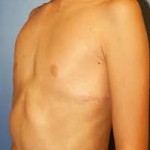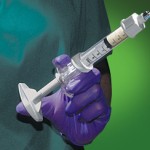
Significant pectus deformities are treated when the patient is young, usually between 12 to 18 years of age. At this age, the plasticity of the cartilages make this age group the ideal period for repair. While extensive cartilage resection (Ravtich approach) has been the historic approach. This radical operation has been replaced by the Nuss Procedure which involves the placement of a large curved bar through incisions on the chest wall. The bar is rotated into position and kept in place for 2 to 3 years.
But not all sternal reconstructive surgery leaves a perfectly flat or well curved sternum. In addition, some patients have very small sternal depressions that were either not recognized for early treatment or were not significant enough for any form of sternal reshaping and respositioning. Such cosmetic sternal deformities have been traditionally treated with onlay implants usually composed of preformed or custom carved silicone. Gore-tex blocks and sheets have also been used as sternal inserts.
But these synthetic materials have not been without their complications including infection, seroma formation, and capsular contracture. This has resulted in either their need for removal or the outcome of a hard and unnatural feeling implant. This is largely because these synthetic materials are not intended to be bone substitutes or replacements so they never integrate and become an extension of the natural sternal bone. Better sternal onlay materials would be an asset and could provide a better option for smaller sternal depressions that don’t warrant invasive bone reshaping.
The ideal sternal onlay augmentation material would adhere to the bone surface, have bone-like firmness and fracture resistance, and be injectable. The need to be delivered into the sternal site by injection is critical as any incision across the sternum is a cosmetic deformity by itself. Of all available bone substitute materials historically used, none fulfill all of these criteria. Most are hydroxyapatite-based which are neither injectable or fracture-resistant.

Kryptonite bone cement has been shown experimentally to be an easily injectable material for limited incision or minimal access cranioplasty. It can flow through small diameter (3mms) plastic tubing, can be easily molded through the skin by outward digital molding pressure, adheres to the bony pocket created, and does not stick to the overlying skin. Its success for a cranial surface suggests that it would work equally well on the sternum, which represents just another flat bone surface. Through a small (< 10mm) lower sternal incision, a subperiosteal pocket can be easily created and injected. The material can be molded to fill a sternal defect and harden in 15 minutes. Once set, it will feel like natural bone and will encapsulate with the underlying sternum
Kryptonite bone cement represents a viable sternal augmentation material. Its ability to be placed by injection opens up treatment possibilities for those with sternal depression deformities that would not otherwise merit more extensive surgical reconstruction.
Dr. Barry Eppley
Indianapolis, Indiana


